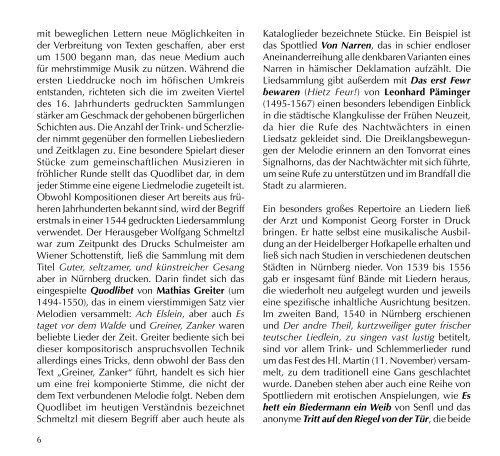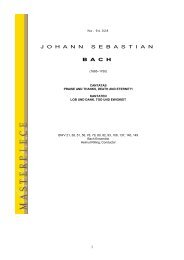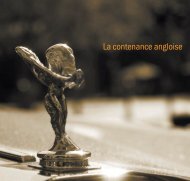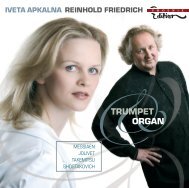gyri gyri gaga - Naxos Music Library
gyri gyri gaga - Naxos Music Library
gyri gyri gaga - Naxos Music Library
Erfolgreiche ePaper selbst erstellen
Machen Sie aus Ihren PDF Publikationen ein blätterbares Flipbook mit unserer einzigartigen Google optimierten e-Paper Software.
German Songs from the Renaissance<br />
Was ist die Welt? (What is the World?) is the start<br />
of a composition by Ludwig Senfl (c. 1490-1543).<br />
A small glimpse into the world of music in the<br />
sixteenth century, but it also conveys a colourful<br />
picture of contemporary entertainment themes<br />
and everyday cares in the many part-songs of the<br />
time. In fact the substance of the song texts is only<br />
difficult to us – sometimes stereotyped phrases<br />
predominate, and only rarely is the name of the<br />
author known – but they often seem to mention<br />
human needs and cares, which are not alien even<br />
to readers and listeners of today. The response to<br />
the above-mentioned song of Senfl, with its image<br />
of late medieval society, is that a pessimistic<br />
philosophy of life in the twenty-first century is not<br />
so very different; money alone dominates a world<br />
characterised by greed and egoism; diligence and<br />
piety are forgotten. Although this stock theme of<br />
lamentation appears repeatedly, the song texts<br />
of the Renaissance also reflect a completely<br />
different world. The happy and boisterous world<br />
of a banquet led Orlando di Lasso (1532?-1594)<br />
in Audite Nova, which jokingly attracts attention<br />
and significance with a formal Latin introduction,<br />
to play afterwards with double entendre words<br />
and syllables in a madrigalesque manner. So that<br />
there sounds here the <strong>gyri</strong> <strong>gyri</strong> <strong>gaga</strong>, which gives<br />
us the title of the present recording. On the other<br />
hand, a further dimension of this world opens up<br />
with the huge group of love-songs, which reveals<br />
a rich emotional life. Mostly it is an impending<br />
farewell or the parting of lovers, which, as in<br />
Caspar Othmayr‘s, (1515-1553), Der Mon[d]<br />
der steht am höchsten (The moon which is at its<br />
highest), are clothed in poetic words and affecting<br />
melodies.<br />
In the musical world of the Renaissance the song<br />
in German stands alongside the genres of the<br />
Mass, the motet and, for example, the chansons<br />
and madrigals imported from France and Italy.<br />
This type of genre for several voices developed<br />
towards the end of the fifteenth century. A known<br />
or newly created melody formed the kernel of the<br />
song; it was often in the tenor. To that two or more<br />
voices were added, which each accompanied the<br />
melody harmonically or polyphonically according<br />
to the type of song. The genre can be divided into<br />
two basic types according to the lay-out of the text<br />
and the musical structure:<br />
Love-songs with stereotyped phrases and complex<br />
verse forms were mostly wrapped up in dense<br />
polyphony. The organist Paul Hofhaimer (1459-<br />
1537) wrote Meins Traurens ist (My sorrow is)<br />
which is a particularly moving lover‘s lament of<br />
this kind. The remarkable opening melody, with<br />
downward and upward leaps of a fifth, matches<br />
that of the psalm (from about 1524) Aus tiefer Not<br />
schrei ich zu dir (Out of the deep have I called<br />
unto thee), which is also in the Phrygian mode.<br />
The end of the verse „and so abandoned thee“ (in<br />
the meaning of „to fade“) is depicted musically<br />
both in the final cadence which follows and in the<br />
depth of the fading run in the bass voice. Another<br />
remarkable piece is Innsbruck ich muss dich<br />
lassen (Innsbruck I must leave thee) by Heinrich<br />
Isaac (c. 1450-1517). He was Court Composer for<br />
the Chapel of Emperor Maximilian I, and his love<br />
10
















